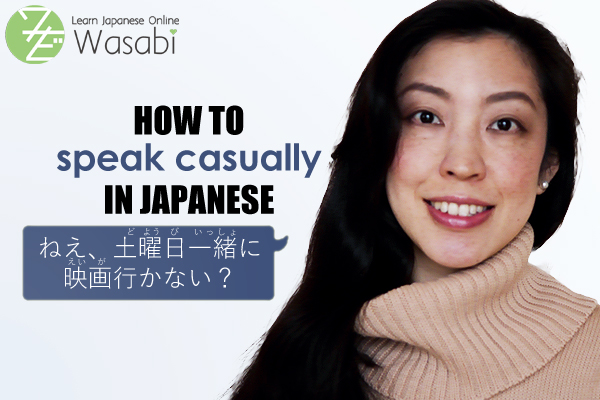How to speak casual Japanese
Welcome back to another “Video & Article” series with tutor Wakako. In this article and video we will talk about how to speak casually in Japanese. Speaking casual Japanese does not only mean leaving out “Keigo”. It involves varying degrees of leaving out and adding particles and exchanging certain stiff or polite words. Let’s take a first look at how to speak casual Japanese!
| Table of Contents [Introduction] [Toning down an example conversation] [Dictionary form & Sentence ending particles] [Omissions] |
[Introduction]
When having a conversation with your friends in Japanese, do you sometimes wonder how polite or casual you should be? The Japanese language has generally two ways to talk: one is polite and the other is causal. Today we will explain how make your spoken Japanese sound more casual.
[adsense]
[Toning down an example conversation]
First of all we will introduce two example conversations. Listen to (via the video) or read each of them to see if you can understand the meaning.
The first conversation is this:
A:すみません、土曜日に一緒に映画に行きませんか?
B:ごめんなさい。土曜日は予定があります。日曜日はどうですか?
A:はい、いいですよ。では日曜日にしましょう。
And the second one goes like this:
A:ねえ、土曜日一緒に映画行かない?
B:ごめん。土曜は予定があるんだ。日曜は?
A:うん、いいよ。じゃあ日曜にしよう。
Did you understand both conversations? If you did, then you may have noticed something. Both of these conversations have the same content, but the first one is spoken in polite Japanese and the second one is casual.
The meaning is this:
A: Hey, why don’t you come to a movie with me on Saturday?
B: I’m sorry I have plans on Saturday. How about Sunday?
A: Sure sounds great. Let’ go on Sunday then.
You may remember this particular grammar point: When you invite someone to do something in Japanese, you can use the polite, present tense negative form of a verb (-“ません”) and put the particle “か” at the end of the sentence. Doing this with the verb “行く”, it becomes: “行きません+か?” This means: Do you want to/Would you like to go?
You can make a similar construct that sounds more casual. To do this, you use the “ない”-form of a verb and omit the particle “か” at the end. In your pronunciation, the intonation still needs to rise at the end. The expression then becomes: “行かない?”↗
[Dictionary form & Sentence ending particles]
In formal conversations, you will usually find yourself using “です” and the “ます”-form of verbs, such as “あります”. But in casual conversations, you can use the dictionary form of a verb plus a sentence ending particle, such as “んだ”. That way “あります” becomes “ある” (dictionary form) and then “あるんだ” if you add the particle.
あります ➡ ある ➡ あるんだ
If you try to speak in a casual tone and just use the dictionary form of a verb without a sentence ending particle, it sounds abrupt and unnatural. Sentence ending particles have functions that indicate the speaker’s mood, emotions, or attitude and often convey friendliness or make the sentence softer. There are many different sentence ending particles, including but not limited to “ね”, “よ”, “よね”, “な(なあ)”, “か”, “わ”, “わよ”, “ぜ”, and “ぞ”.
Let’s combine all of them with the dictionary form of the word “to eat”: “食べる”. “↘” indicates a falling intonation, “↗” indicates a rising intonation.
食べる + ね
食べる + よ
食べる + よね
食べる + な(なあ) ↘ *
食べる + か ↘ (men/both)
食べる + わ ↗ (women) ↘ (men/both)
食べる + わよ (women)
食べる + ぞ (men/both)
食べる + ぜ (men)
Some particles, as indicated above, may sound more masculine or feminine. “ぜ” for example is mostly used by men because it sounds masculine, and “わ” and “わよ” are usually only used by women, since they sound feminine.
Each particle has a subtle nuance. So the nuance when you say “土曜は予定があるんだ” and “土曜は予定があるわ” are different (imagine it like reading it in a different tone or voice).
How to use these sentence ending particles is one of the most difficult parts of learning Japanese. We will talk about them more in our next lesson.
You can also check out some other articles about sentence ending particles on Wasabi here and here.
[Omissions]
Another character of casual conversations is that it uses many omissions.
“日曜日はどうですか?”
Becomes:
“日曜は?”
You can omit “どうですか?” and just use noun + particle “は” with a rising intonation. That way it becomes an interrogative sentence.
How to say “Yes” and “No” also changes depending on whether you are using a formal or casual tone. As you know, yes and now mean “はい” and “いいえ” in Japanese, but they change to “うん” and “ううん” in a casual tone.
We often hear learners of Japanese are confused about casual Japanese and have difficulties understanding it, because many Japanese textbooks start with and focus only on formal forms for beginners and even intermediate students. It might be difficult to make your spoken Japanese sound more casual and natural. But if you watch many Japanese TV shows or YouTube videos, over time you will get familiar with the casual tone and start to understand the differences between subtle nuances of the various sentence ending particles.
That is all for today’s lesson. If you have any questions you can always clear them up by booking a lesson with one of our native Japanese tutors. See you next time!
| 迷う | To get lost, to be puzzled |
| 丁寧 | Polite |
| 予定 | Plans, arrangement |
| 一緒に | Together |
| 映画を見に行く | To go watch a movie |





